
County Clare is a county in Ireland, in the Mid-West Region and the province of Munster, bordered on the west by the Atlantic Ocean. Clare County Council is the local authority. The county had a population of 118,817 at the 2016 census. The county town and largest settlement is Ennis.

Bunratty Castle is a large 15th-century tower house in County Clare, Ireland. It is located in the centre of Bunratty village, by the N18 road between Limerick and Ennis, near Shannon Town and its airport. The castle and the adjoining folk park are run by Shannon Heritage as tourist attractions.

Cratloe is a village in County Clare, Ireland, situated between Limerick and Shannon in the mid-west of Ireland. It is possible that the name derives from Croit-shliabh meaning "hump-backed hill", referring to Woodcock Hill. The present-day parish of Cratloe consists of the former parish of Kilfintinan and a portion of the contemporary parish of Killeely. This was agreed upon by priests in the 18th century, who claimed there were not enough members of the clergy to operate fully in both parishes.
The Battle of Dysert O'Dea took place on 10 May 1318 at Dysert O'Dea near Corofin, Ireland. It was part of the Bruce campaign in Ireland. The Norman Richard de Clare attacked the Gaelic Irish chieftain Conchobhar Ó Deághaidh, chief of the Cineal Fearmaic and ally of Muircheartach Ó Briain, but he was defeated.

Dromoland Castle is a castle, located near Newmarket-on-Fergus in County Clare, Ireland. It is operated as a 5-star luxury hotel with a golf course, with its restaurant, the Earl of Thomond, being awarded a Michelin star in 1995, under head chef Jean Baptiste Molinari.
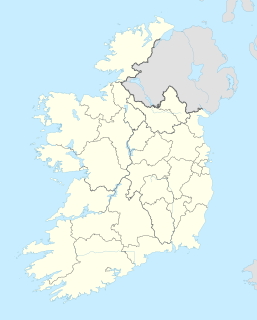
Liscannor is a coastal village in County Clare, Ireland.

Corofin is a village on the River Fergus in northern County Clare in Ireland and a Catholic parish with the same name.
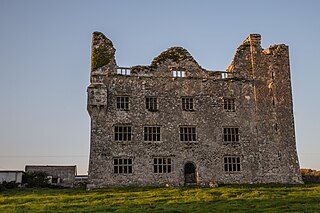
Leamaneh Castle is a ruined castle located in the townland of Leamaneh North, parish of Kilnaboy, between the villages of Corofin and Kilfenora at the border of the region known as the Burren in County Clare, Ireland. It consists of a 15th-century tower house and a 17th-century mansion.

Tubber is a village in the north of County Clare, Ireland.
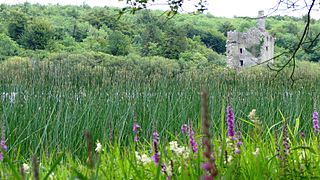
Ruan is a village in County Clare in Ireland and a civil parish by the same name. It is in the Catholic parish of Dysart and Ruan.
The High Sheriff of Clare was a High Sheriff title. Records show that the title was in existence from at least the late 16th century, though it is not used today in the modern Republic of Ireland. The title existed within County Clare in the west of Ireland during the time of the Kingdom of Ireland and then as part of the United Kingdom of Great Britain and Ireland.

Dysert is a civil parish in County Clare, Ireland. The parish was formerly called Dysert O’Dea, from its having been the territory of the sept of that name. It is part of the ecclesiastical parish of Dysart and Ruan. The ruins of O'Dea Castle and a 12th-century church of Dysert O'Dea Monastery are in the townland of the same name.
Connor O'Brien, 3rd Earl of Thomond, called Groibleach, grandson of Conor O'Brien ; succeeded to the earldom, 1553; his right to the lordship of Thomond was disputed by his uncle, Donnell; confirmed in his possessions by Thomas Radclyffe, 3rd Earl of Sussex in 1558, who proclaimed his uncles traitors, though peace was not established until 1565. He intrigued with Fitzgerald in 1569, and fled to France; returned to Ireland and received pardon, 1571, with the restoration of his lands, 1573.

Donogh O'Brien, 4th Earl of Thomond and Baron of Ibrickan was an Irish nobleman and soldier noted for his loyalty to the Kingdom of Ireland. He fought for the Queen in Tyrone's Rebellion and notably at the Siege of Kinsale. His long-term objective, achieved after decades, was to obtain an official acknowledgment that County Clare, where his possessions were situated, was part of the province of Munster, to free it from the jurisdiction of the Connaught government under which it had been placed.
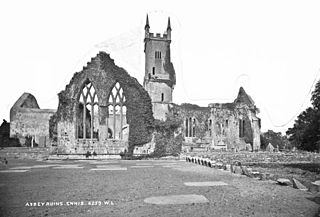
Drumcliff, or Drumcliffe, Dromcliffe is a civil parish in County Clare, Ireland. It includes the village of Inch and part of the town of Ennis.

Ballyhannon Castle is a medieval Irish castle dating back to the 15th century, located near the village of Quin in County Clare, on the west coast of Ireland. It is fully intact and in the Irish Governmental records it is registered as a National Monument and "Listed/Protected" structure, intended to protect its historic, architectural and aesthetic significance.
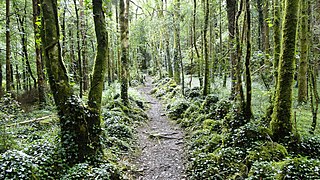
Dromore, County Clare is a rural townland in County Clare in the Republic of Ireland. It is located in the parish of Ruan and was formerly the location of Dromore House. Today, most of the townland is accounted for by Dromore Wood Nature Reserve. It is open to the public and also contains the ruins of Dromore Castle.

Dysart and Ruan is a Catholic parish in County Clare, Ireland. It covers the civil parishes of Ruan and Dysert, and includes the village of Ruan, which holds the parish office. The parish contains the ruins of the 12th century St. Tola's Church, part of Dysert O'Dea Monastery.
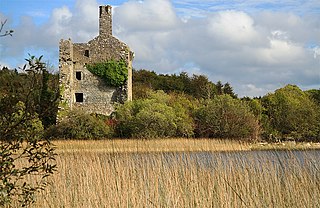
Dromore Lough is a freshwater lake in the Mid-West Region of Ireland. It is located in County Clare.
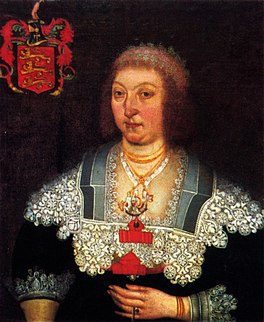
Máire Rua O'Brien was an Irish aristocrat who married three times to retain family lands. Born into the MacMahon family of Thomond, her name, Máire Rua or Red Mary, derived from her red hair. First married to Daniel Neylon (O'Neillan) of Dysert O'Dea Castle in north County Clare, after his death in 1639, she married Conor O'Brien of Leamaneh Castle. With her second husband, she backed the Confederate cause against Cromwell's forces during the Eleven Years' War. However, after her second husband was killed in 1651, she married a Cromwellian officer; in a reputed attempt to save her estate. Remaining on her estate at Leamaneh for several decades, her son Donough O'Brien moved the family seat to the larger Dromoland Castle where she lived until her death in 1686. A sometimes notorious figure in Irish folklore, a number of exaggerated stories and legends are associated with her life.




















